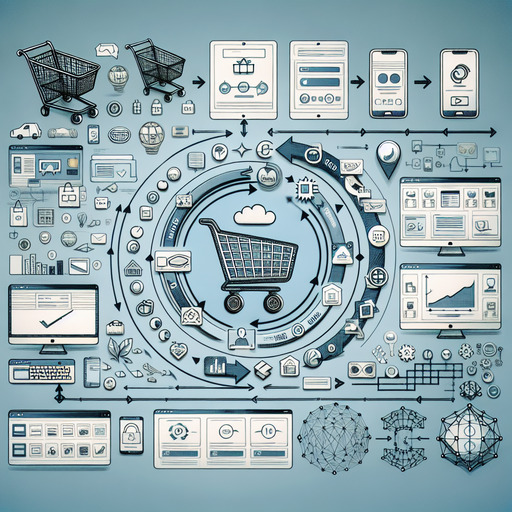
-
Table of Contents
Discover Stunning Web Design Inspiration for Your E-commerce Site! Get Inspired Now
Introduction
In the rapidly evolving digital marketplace, the design of an e-commerce website plays a pivotal role in attracting and retaining customers. Web design inspiration for e-commerce sites encompasses a blend of aesthetics, functionality, and user experience to create visually appealing and highly efficient online stores. Effective e-commerce web design not only captivates visitors with its visual appeal but also ensures seamless navigation, quick loading times, and an intuitive shopping experience. By integrating the latest design trends, innovative layouts, and user-centric features, businesses can enhance their online presence, boost customer engagement, and drive sales. Whether through minimalist designs, bold typography, or interactive elements, the goal is to create a compelling and memorable shopping journey that converts visitors into loyal customers.
Top 10 Web Design Trends for E-commerce Sites in 2023: Elevate Your Online Store with Custom Web Design and Responsive Web Design Services
In 2023, the landscape of e-commerce web design is evolving rapidly, driven by technological advancements and changing consumer preferences. To stay competitive, online stores must embrace the latest web design trends that not only enhance aesthetics but also improve functionality and user experience. Custom web design and responsive web design services are pivotal in this transformation, ensuring that e-commerce sites are both visually appealing and highly functional across all devices.
One of the most prominent trends is the integration of immersive experiences through augmented reality (AR) and virtual reality (VR). These technologies allow customers to visualize products in their own environment before making a purchase, significantly reducing the uncertainty that often accompanies online shopping. For instance, furniture retailers can offer AR features that let users see how a sofa would look in their living room, thereby enhancing the decision-making process.
Another trend gaining traction is the use of micro-interactions. These are subtle animations or design elements that respond to user actions, such as a button changing color when hovered over or a product image zooming in when clicked. Micro-interactions add a layer of interactivity and engagement, making the shopping experience more enjoyable and intuitive. They also provide immediate feedback, which can guide users through the purchasing process more smoothly.
Sustainability is also becoming a key consideration in web design. Consumers are increasingly aware of environmental issues and prefer to support brands that demonstrate a commitment to sustainability. E-commerce sites can reflect this by using eco-friendly design elements, such as earthy color palettes, recycled textures, and minimalistic layouts that reduce digital clutter. Additionally, highlighting sustainable practices and products on the website can resonate well with eco-conscious shoppers.
Personalization continues to be a critical factor in e-commerce success. Advanced algorithms and machine learning enable websites to offer personalized recommendations based on user behavior and preferences. This trend extends to web design, where dynamic content can be tailored to individual users. For example, a returning customer might see a homepage featuring products similar to their previous purchases, creating a more relevant and engaging experience.
Mobile-first design is no longer optional but essential. With the majority of online shopping now occurring on mobile devices, e-commerce sites must prioritize responsive web design services to ensure seamless functionality across all screen sizes. This includes optimizing load times, simplifying navigation, and ensuring that all interactive elements are easily accessible on smaller screens. A mobile-first approach not only improves user experience but also boosts search engine rankings, as search engines increasingly favor mobile-friendly sites.
The use of bold typography and vibrant colors is another trend that can make e-commerce sites stand out. Large, eye-catching fonts can draw attention to key messages and calls to action, while a well-chosen color scheme can evoke specific emotions and brand identity. However, it’s crucial to strike a balance between bold design elements and overall readability to maintain a professional appearance.
Storytelling through design is also becoming more prevalent. E-commerce sites are using visual narratives to convey their brand story, values, and product benefits. This can be achieved through a combination of high-quality images, videos, and compelling copy. A well-told story can create an emotional connection with customers, fostering brand loyalty and encouraging repeat purchases.
Incorporating social proof is another effective strategy. Displaying customer reviews, testimonials, and user-generated content can build trust and credibility. Potential buyers are more likely to make a purchase if they see positive feedback from other customers. Integrating social media feeds and sharing options can also enhance community engagement and brand visibility.
Lastly, minimalism remains a timeless trend. A clean, uncluttered design can make navigation easier and help users focus on the products. By eliminating unnecessary elements and focusing on essential features, e-commerce sites can provide a more streamlined and efficient shopping experience.
In conclusion, the top web design trends for e-commerce sites in 2023 emphasize the importance of custom web design and responsive web design services. By incorporating immersive technologies, micro-interactions, sustainability, personalization, mobile-first design, bold typography, storytelling, social proof, and minimalism, online stores can elevate their user experience and stay ahead in the competitive e-commerce landscape.
Q&A
**Question:** What are some key elements to consider for web design inspiration for e-commerce sites?
**Answer:** Key elements to consider for web design inspiration for e-commerce sites include:
1. **User-Friendly Navigation:** Ensure easy access to product categories and search functionality.
2. **Responsive Design:** Optimize for various devices, including mobile and tablets.
3. **High-Quality Images:** Use professional, high-resolution images for products.
4. **Clear Call-to-Actions (CTAs):** Make CTAs prominent and compelling to drive conversions.
5. **Fast Loading Times:** Optimize site speed to reduce bounce rates.
6. **Trust Signals:** Include customer reviews, testimonials, and security badges.
7. **Minimalist Design:** Avoid clutter to keep the focus on products.
8. **Personalization:** Use data to offer personalized recommendations and experiences.
9. **Easy Checkout Process:** Simplify the checkout process to reduce cart abandonment.
10. **Consistent Branding:** Maintain a cohesive brand identity throughout the site.